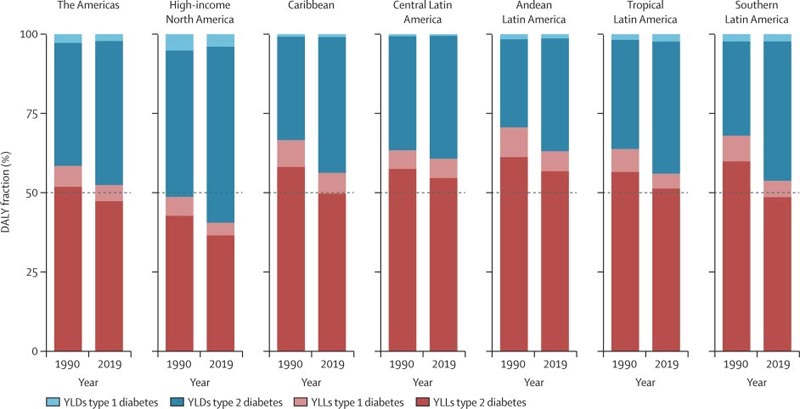Highlights This study estimated the burden of type 1 and 2 diabetes in the Americas from 1990 to 2019 using estimates from GBD 2019. Diabetes accounted for 5% to 9% of all deaths in the Americas in adults aged 20 years and older. The burden of type 1 and type 2 diabetes has increased since 1990 due to increasing prevalence. The disability burden fraction has increased and represents half of the total burden in 2019. It has been estimated that the burden of diabetes is large and expanding. We need to focus on population-based interventions to reduce risk and provide quality, efficient care to people affected by diabetes. |
Background
A high prevalence of diabetes has been reported in the Americas, but a comprehensive analysis of the burden of diabetes and related factors is not available for the region. Our objective was to describe the burden of type 1 and type 2 diabetes and hyperglycemia in the Americas from 1990 to 2019.
Methods
We used GBD 2019 estimates to assess the burden of diabetes in adults aged 20 years and older and high fasting plasma glucose in adults aged 25 years and older in the 39 countries and territories of the six regions of the Americas from 1990 to 2019. The main source for estimating mortality attributable to diabetes and chronic kidney disease due to diabetes was the civil registry.
Mortality due to diabetes in general (i.e., diabetes and diabetes due to chronic kidney disease) was estimated using the cause-of-death ensemble model . Years of life lost (YLL) were calculated as the number of deaths multiplied by the standard life expectancy at the age at which death occurred, years lived with disability (YLD) were estimated based on the prevalence and severity of complications of diabetes.
Disability-adjusted life years ( DALYs) were estimated as a sum of YLD and YLL. We assessed the association of diabetes burden with a country’s level of development (based on the Sociodemographic Index), access and quality of healthcare (estimated with the Healthcare Access and Quality Index), and the prevalence of diabetes. diabetes.
We also calculated the population attributable fraction (PAF) of the diabetes burden due to each of its risk factors. We report 95% uncertainty intervals for all estimates.
Results
In 2019, an estimated total of 409,000 (95% uncertainty interval 373,000-443,000) adults aged 20 years and older in the Americas died from diabetes , accounting for 5.9% of all deaths.
Diabetes was responsible for 2266 (1930-2649) crude DALYs per 100,000 adults in the Americas, and high fasting plasma glucose for 4401 DALYs ( 3685-5265) per 100,000 adults, with large variation between regions. DALYs were mainly due to type 2 diabetes and the distribution was heterogeneous, being highest in central Latin America and the Caribbean and lowest in high-income North America and southern Latin America.
Between 1990 and 2019, age-standardized DALYs due to type 2 diabetes increased by 27.4% (22.0-32.5). This increase was particularly high in Andean Latin America and high-income North America.
The burden of type 1 and type 2 diabetes in countries increased with higher diabetes prevalence and decreased with higher sociodemographic and healthcare access and quality indices.
The main risk factors for burden were high BMI, with a population attributable fraction (PAF) of 63.2%, and dietary risks, with a PAF of 27.5%. The fraction of the disability burden has increased since 1990 and now represents almost half of the total burden in 2019.

Figure : Percentage of the total burden of diabetes for all ages expressed as disability (YLD) and premature mortality (YLL) between regions of the Americas in 1990 and 2019, both sexes YLDs=years lived with disability. YLLs=years of life lost. * Over 20 years old.
Interpretation
The burden of diabetes in the Americas is large, growing, heterogeneous and expanding. To address the growing burden, population-based interventions aimed at reducing the risk of type 2 diabetes and strengthening health systems to provide effective and cost-effective care to those affected are mandatory.
Implications of all available evidence
- The burden of diabetes continues to increase and expand in the Americas. Unless strong action is taken, this burden is likely to increase further in the foreseeable future, given the increasing prevalence of diabetes.
- While improved access to high-quality healthcare is greatly needed in the region, it is essential to aggressively implement public health policies aimed at the primary prevention of type 2 diabetes.
Discussion
The burden of diabetes in the Americas is large, heterogeneous, and growing, especially for type 2 diabetes.
Several countries in central Latin America and the Caribbean are particularly affected. Diabetes prevalence explained most of the variability in diabetes burden across countries, with access to better quality healthcare and sociodemographic development also being important determinants.
Well-characterized risk factors for type 2 diabetes (high body mass index and dietary risks) were the main determinants of the burden of type 2 diabetes. Although mortality continued to constitute the majority of the burden of diabetes, the burden of disability increased progressively from 1990 to 2019.
The burden of diabetes for the Americas in 2019: 5.9% of all deaths and 2,266 DALYs per 100,000 adults directly from diabetes and chronic kidney disease due to diabetes, and approximately double considering the total burden of plasma glucose high fasting: diabetes is among the main causes of health loss in the Americas.
The burden was considerably higher in the most affected regions of central Latin America and the Caribbean. Our findings for the Americas parallel the published GBD 2016 estimate that diabetes (if the burden of chronic kidney disease due to diabetes is also considered) will, by 2040, be the second leading disease causing deaths in countries of the Americas. low and middle income in Latin America. America and the Caribbean and that high fasting plasma glucose is currently the world’s third most important risk factor for disease burden.
The current burden of diabetes and hyperglycemia, expressed entirely through high fasting plasma glucose levels and without adjustment for age, is currently concentrated in the three northern regions. The majority of this burden (92.6%) is due to type 2 diabetes, the prevalence of which has increased by 45.2% since 1990.
Taking into account the close association of the burden of diabetes with its prevalence, the fact that the largest increases in prevalence were observed in the Andean (68.3%) and southern (79.8%) regions of Latin America , which currently have a lower prevalence, indicate that the burden of diabetes in the Americas is now expanding .
Therefore, reducing the diabetes epidemic, a major challenge for the Americas, will require greater use of population-based strategies, given their broad reach and low cost. Ways must be developed to calm political controversy over the extent to which the government should regulate market activity in the interest of public health and restrict economic interests that block the implementation of these policies.
Funding : Bill and Melinda Gates Foundation.
















